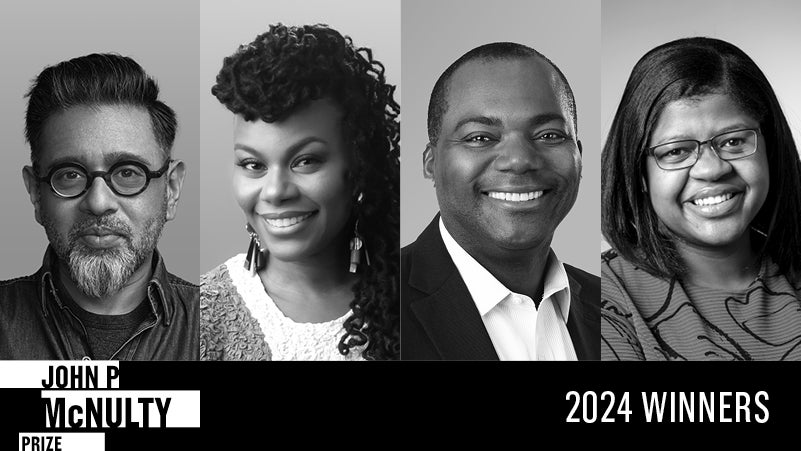Young changemakers have long been left out of discussions with top members of government and society. In the eyes of policymakers and legacy industries, people under 30 have too little experience and too little knowledge to add value to systems-level decisions. Yet, the age-old adage that children are meant to be seen and not heard has one glaring new exception: climate change.
Nowhere has this been more apparent than at Vice President Kamala Harris’s Earth Day Celebration. Hosted by the White House in collaboration with Native Americans in Philanthropy, Biodiversity Funders Group, and Climate and Energy Funders Group, the event brought together a diverse collection of philanthropists, policymakers, and advocates for environmental justice. A notable number of attendees were students and young professionals, including six Aspen Institute Future Climate Leaders (the authors) who were determined to make the most of this opportunity.
To do that, we crafted a two pager in anticipation of the White House event, which details major youth action and policy challenges that can be solved by involving the next generation in leadership roles. We also handed out business cards with an email address, a QR code to the two-pager, and a very direct ask to “Place young leaders in positions of influence across the federal government to facilitate intergenerational climate action.”
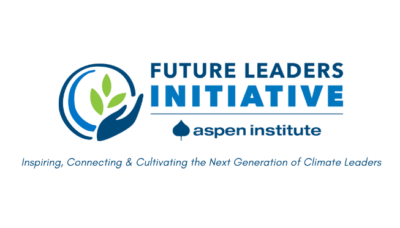
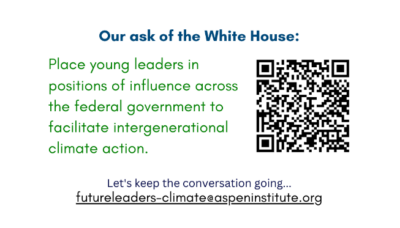
In reality, the results of our plan were a bit discouraging (a poolside program with tasty vegetarian bites and a live performance by Ellie Goulding is a lot more appealing than reading a two pager), but our ideas were highly praised and well received. Below are five takeaways from our experience at the Earth Day Celebration, along with ways they can be applied to broader youth climate leadership.
The most powerful call to action is a personal story.
During her address, Vice President Harris shared,
“I grew up in California, where we had one of the first major droughts when I was a kid, so I became aware at a very early stage of my life of the precious nature of all of these natural resources and the importance of thinking of individual responsibility and self-determination as an extension of how we think about the work we must do.”
Water policy and technology were arguably the biggest themes of the Vice President’s speech. After beginning with her own story, the VP transitioned into examples of water innovations she discovered in her travels and ways that she is using her office to elevate the voices and ideas of water leaders. These included vertical agriculture farmers in Zambia and civic entrepreneurs in Thailand.
Inspired by these stories, Aspen Institute Future Leader Bodhi Patil engaged Ellie Goulding about Ocean Uprise, his youth-led platform for ocean-climate action. Like the Vice President’s narrative of her experience in California, Bodhi found that recounting his childhood passion for coral reefs was the most effective approach for holding her attention.
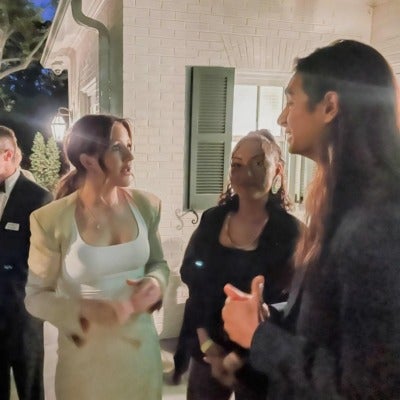
Make yourself memorable by being specific and having a plan.
While it feels intimidating to approach prominent figures, it is always worth a shot but make sure you know what you want to talk to them about. You can even practice talking about these topics with people in your life. Always have your good ideas and topics on the tip of your tongue so that your passion and clear understanding of the issue will shine when the moment comes for you to make your pitch.
At the entrance to the Vice President’s Residence, Aspen Future Leader Robert Fetell recognized White House National Climate Advisor Ali Zaidi. Immediately, he realized this happenstance was an opportunity to communicate the importance of his research on mine tailings storage and to learn about White House initiatives geared at addressing hazardous waste generation as a consequence of the clean energy transition.
Robert went on to have a productive conversation with Zaidi, who took the Future Leaders business card and seemed impressed by our call to action. With growing confidence, Robert then went on to connect with Erik Stegman, the CEO of Native Americans in Philanthropy, about opening a dialogue expanding socio-technical research into solutions for Indigenous water and land rights.
Robert’s experience reminds us that our academic interests can spark engaging and memorable conversations that stick in the minds of those who can drive change. A memorable interaction is a strong start towards making an impact as a young climate leader.
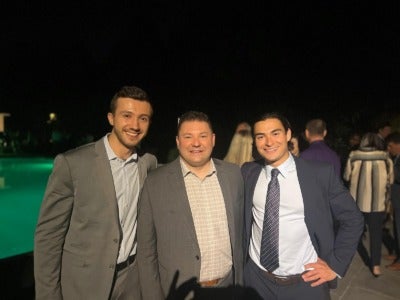
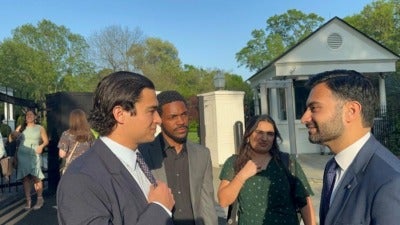
Listening is key to inclusive climate leadership and collaboration.
VP Harris asked a simple question of the audience, “Who is a part of this coalition?” She proceeded to answer:
“We’re talking about Moms and Dads and Grandparents, about students, scientists, firefighters, environmentalists, and entrepreneurs. I mean just name it, and they are a part of our movement, or we are engaging them to be a part of our movement.”
Marginalized communities, blue collar workers, and the wealthy—of all ages—share this planet together. We may be impacted in different ways and to different extents, but we all care about nature and we all care about the next generation. Focusing on our shared love of the earth by encouraging others to share what they are doing is a clever way to build coalitions despite differing approaches and sub-agendas.
For instance, Aspen Future Leader Max Sano listened to students and experienced professionals at the reception about actions their organizations are taking to advocate for environmental justice. Be it fundraising, research, communications, or lobbying, everyone he met found a way to play to their strengths and experiences.
Max met young people from across the nation as they were recognized for organizing sustainability initiatives on their college campuses, representing Indigenous and First Nation communities, or studying engineering and food systems reform. Across the pool there were leaders of the Democratic Party at the state and federal level, CEOs, and heads of legacy environmental nonprofits buzzing with excitement over policy wins during the Biden Administration.
Max’s biggest takeaway was that an incredible energy can be unlocked by simply asking the right questions and listening. By getting people to share what they are most excited about in the climate space, you light up their enthusiasm and pave a path towards intersectional and intergenerational collaboration.
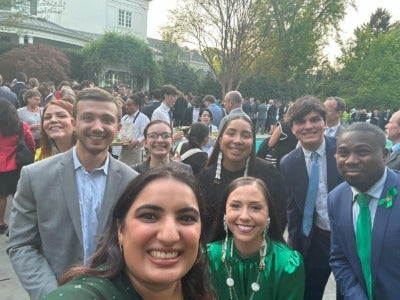
The next generation is already taking leadership on climate advocacy.
Optimism was a major theme of the Vice President’s remarks. More than once, she reframed climate change as a chance to do good:
“We’re aware of the crisis, but then let us think about this moment in the context of the extraordinary opportunities in front of us. I am so excited about what we are in the midst of creating in terms of a clean energy economy…On this Earth Day, as we celebrate, let us be fueled with a sense of excitement about what is possible in the face of a crisis.”
Climate change is one arena where the voices and ideas of our future leaders are genuinely valued. McKenna Dunbar, an Aspen Institute Future Leader in attendance, experienced this firsthand. As a board advisor for Climate Mental Health Network and an energy justice organizer at Sierra Club who works on reducing energy burdens with institutionally underserved communities in the South, their insights on climate mental health at Aspen Ideas: Climate have resonated with the Vice President and so many others.
McKenna reframed the crisis as a springboard for raising awareness and driving progress. McKenna’s responses to the VP’s question of “Tell me how you’re talking with your peers, how are you experiencing climate change?” at Aspen Ideas: Climate inspired the Vice President to publicly acknowledge the term “climate anxiety” in multiple public forums.
This poignant phrase captures the emotional, psychological, and mental toll that the climate crisis imposes on our youth, which is getting more recognition thanks to McKenna’s conversation with the Vice President.
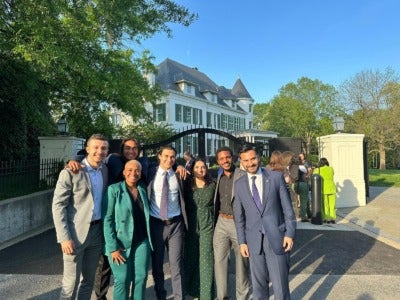
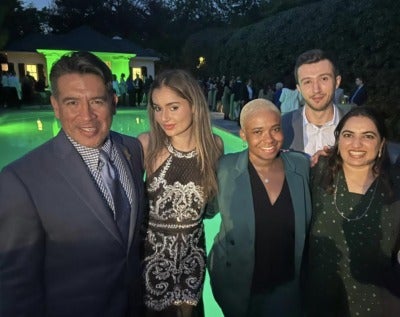
Momentum is on our side!
The Earth Day Celebration had a palpable energy of optimism. Sure, climate change is a bummer. But being part of the solution is fun and inspiring.
As the Vice President said, “We’ve got momentum!”—$1 trillion in climate funding from the federal government is more money than anyone has given out for anything, ever! And just like the Inflation Reduction Act, the Earth Day Celebration was a clear signal that our leaders are starting to steer the country’s course towards a more sustainable and equitable future—a future that we will be proud to leave behind for generations to come.
Young leaders inherently contribute long-term thinking to discussions and decisions because, after all, it is they who will be captaining the ship when the consequences of climate change have escalated. The length of our runway, and the increasing severity of the climate crisis, reveals that there is no one better suited to be at the table than us: the ones with the most to lose if we do nothing, but the most to gain if we work together.

